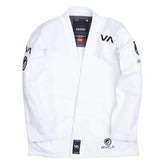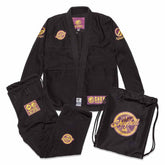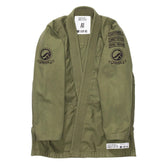The Importance of Proper Footwear for BJJ Training
Brazilian Jiu-Jitsu (BJJ) is a dynamic and highly technical martial art. It demands agility, balance and strong footwork. It emphasizes ground fighting, technique, and leverage over brute strength. BJJ is traditionally practiced barefoot. However, the role of proper footwear in training, conditioning, and hygiene cannot be overlooked. Whether for off-the-mat conditioning, wrestling integration or hygiene, footwears play an important role.
In this article, we will explore why choosing the right footwear is essential for BJJ athletes. It will also explore how it impacts performance, and how to maintain optimal foot health.
1- Why is Footwear Important in BJJ Training?
Most BJJ competitions and academies require athletes to train barefoot. However, footwear plays a crucial role in supplementary training, warm-ups, strength conditioning, and injury prevention. Wearing the right shoes for training can significantly enhance your overall performance.
a- Protection from Injuries
One of the primary reasons for using proper footwear in BJJ training is injury prevention. Grapplers often experience foot and ankle injuries. The injuries occur due to twisting motions, sudden pivots, and intense pressure on the lower limbs. BJJ involves dynamic movements, takedowns, and rapid footwork. Training on mats with unprotected feet can lead to:
- Mat burns that cause skin irritation.
- Toe injuries from sudden movements or accidental impacts.
- Foot sprains and fractures due to high-impact training.
Wearing the right BJJ training shoes during strength and conditioning sessions can provide:
- Enhanced ankle support – Reducing the risk of sprains and strains.
- Shock absorption – Lessening the impact of jumps and takedowns.
- Better grip – Preventing accidental slips that could lead to injuries.
b- Hygiene and Mat Safety
Foot hygiene is a crucial aspect of BJJ training. Mats in BJJ academies can harbor bacteria, fungi, and other pathogens. Training barefoot on mats exposes practitioners to bacteria and fungi. This increases the risk of skin infections such as ringworm, athlete’s foot, and staph infections. Using BJJ-specific training shoes when off the mat helps to:
- Prevent the spread of germs – Keeping mats clean and reducing the risk of infections.
- Maintain foot protection – Avoiding cuts, scrapes, and blisters from rough surfaces.
- Ensure gym etiquette – Many gyms enforce rules about foot cleanliness. Thus, emphasizing the need for dedicated footwear.
c- The Role of Footwear in Strength and Conditioning
BJJ training extends beyond the mats to include strength and conditioning workouts. Proper footwear in these sessions is important for improving performance and reducing strain. A better grip enhances footwork, balance and control, which are essential for takedowns and guard passing. The right shoes can enhance:
- Weightlifting stability – A flat, firm base helps in squats, deadlifts, and explosive movements.
- Cardio efficiency – Running and agility drills are safer and more effective with the right footwear.
- Foot arch support – Reducing long-term foot fatigue and discomfort.
d- Wrestling Shoes vs. Barefoot Training
Some BJJ practitioners integrate wrestling techniques into their game. Here footwear becomes even more relevant. Wrestling shoes offer several advantages, including:
- Superior grip and traction – Allowing for explosive takedowns and scrambles.
- Foot and ankle protection – Reducing hyperextension and injuries.
- Increased mobility – Enabling smooth transitions between standing and ground positions.
However, it’s important to note that some BJJ gyms may not allow wrestling shoes on the mat due to hygiene concerns. So, always check your academy’s policies.
2- Types of Footwear Used in BJJ Training
When selecting footwear for BJJ-related training, consider the following:
- Mat-friendly materials – Soft-soled shoes that won’t damage mats.
- Lightweight and flexible design – Ensuring ease of movement.
- Breathability and comfort – Preventing excess sweating and blisters.
- Durability and support – Long-lasting protection for intense workouts.
Barefoot training remains the standard. However, different types of footwear can support various aspects of BJJ training and conditioning. These types include:
a- Wrestling Shoes for BJJ
Many BJJ practitioners use wrestling shoes when cross-training in takedown-heavy disciplines like No-Gi BJJ, wrestling, or Sambo. These shoes offer:
- Better ankle support to prevent rolling or spraining.
- Enhanced grip on the mats for improved footwork.
- Protection against toe injuries during intense grappling.
b- Grappling Socks and Hybrid Footwear
These are for those looking for a barefoot feel. With added protection, grappling socks or hybrid BJJ shoes offer flexibility, grip, and hygiene. Moreover, they do not restrict the movement. These are particularly useful for:
- Open mat sparring sessions.
- Training on outdoor surfaces or cold gym floors.
- Protecting cuts or blisters on the feet.
c- BJJ Sandals and Slides
Every BJJ athlete should own a pair of BJJ sandals or slides for walking off the mats. Wearing them prevents direct contact with dirt, sweat, and bacteria. Thus, maintaining hygiene in the training environment.
3- Choosing the Right Footwear for BJJ Training
When selecting the best BJJ footwear, consider the following factors:
a- Comfort and Fit
The footwear should fit snugly but not be too tight. Wrestling shoes, in particular, should provide ankle support without restricting movement.
b- Grip and Traction
A strong grip is essential to prevent slipping. Look for shoes with a non-marking rubber sole. It provides a good balance of traction and flexibility.
c- Breathability and Hygiene
Choose lightweight and breathable materials to prevent sweat buildup and odor. Shoes with mesh panels or moisture-wicking fabric are ideal for keeping feet dry and fresh.
d- Durability and Material
Since BJJ training is intense, your footwear should be made from durable synthetic leather or reinforced fabric to withstand wear and tear.
4- Common Misconceptions About BJJ Footwear
a- BJJ Must Always Be Practiced Barefoot
Barefoot training is traditional. However, footwear is essential for strength training, outdoor drills, and injury protection. Many top-level grapplers incorporate wrestling shoes for drills to improve takedown skills.
b- Wrestling Shoes Make You Slower
On the contrary, wrestling shoes enhance footwork by providing stability and grip. Thus making movements more precise and explosive.
c- Footwear is Only for Beginners
Even elite BJJ competitors and black belts use proper footwear for conditioning, weightlifting, and specialized training.
Final Thoughts: Elevate Your BJJ Training with Proper Footwear
It does not matter whether you’re a beginner or an experienced practitioner. Investing in proper BJJ footwear can significantly enhance your training experience. Barefoot rolling is fundamental to BJJ. However, using grappling shoes, wrestling shoes or socks for training sessions provides numerous benefits. These benefits include injury prevention, hygiene, and improved performance. It does not matter whether it’s for injury prevention, hygiene, or conditioning. Investing in the right footwear enhances performance and longevity in the sport.
By incorporating high-quality BJJ training shoes, wrestling shoes, and conditioning footwear, athletes can improve their grip, protect their feet, and stay ahead in their grappling journey. Stay safe, train smart, and always choose the best footwear for your BJJ lifestyle!
For more expert insights on Brazilian Jiu-Jitsu gear and training, explore our latest collection of bjj gear and accessories at Novakik BJJ


















